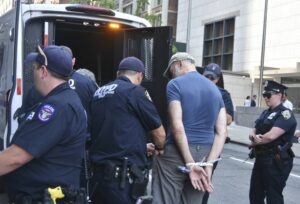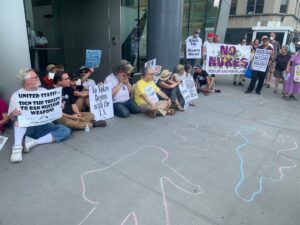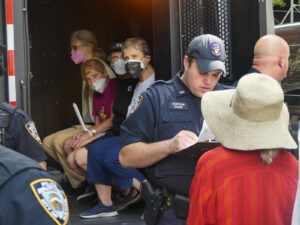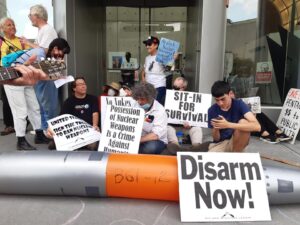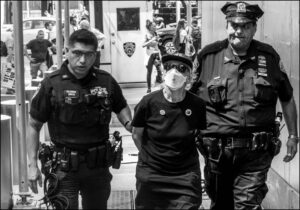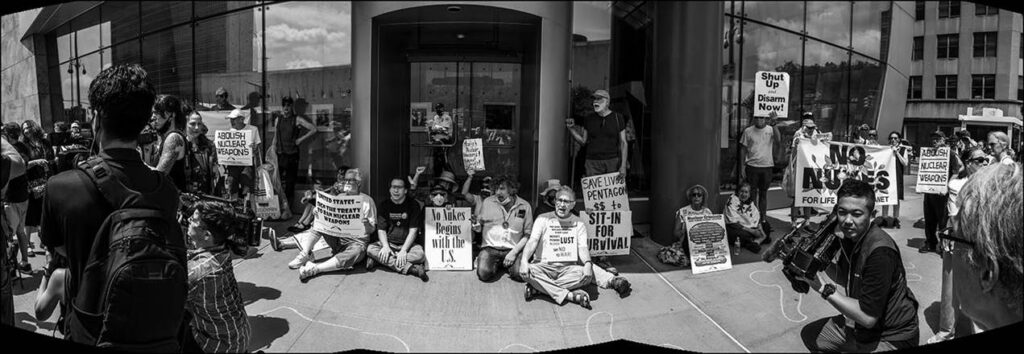from Ed Hedemann
On August 2, for almost four hours on a sunny and rather hot Tuesday, the NYC War Resisters League along with several other peace, social justice and environmental organizations were part of a nonviolent sit-in at the U.S. Mission during the second day of the U.N.’s month-long Nuclear Nonproliferation Treaty Review Conference. About 100 participated in the demonstration, eleven of whom were eventually arrested while blocking the two doors to the U.S. Mission.
Our goal was to disrupt “nuclear diplomacy” as usual — which for decades has meant talk talk talk with little to no action — to demand the United States and other “nuclear countries” get rid of their nuclear weapons, especially in this time of increased nuclear saber-rattling around the war in Ukraine.
The demonstration began at the U.N.’s Isaiah Wall with the holding of signs and banners, vigiling, singing, and street theater before we marched two blocks up First Avenue to the U.S. Mission, which sits directly across the street from the United Nations. That’s when the sit-in began, which managed to shut down the Mission for a couple hours until the police arrested all the demonstrators.
Inside the Mission during our demonstration, there was an announcement directed to employees that because of “civil unrest” outside, employees needed to “shelter in place”! Until the arrests were completed, no one entered or left the Mission.
Despite that over-the-top Mission warning, the demonstration attracted a lot of visitors, including reporters, tourists, delegates from the U.N. conference, a Japanese Hibakusha from Hiroshima who was 9 months old when he survived the bombing, and even “Miss Teen Pacific” in her tiara who joined the sit-in long enough to hold one of our signs and pose for a selfie.
xxx
from a press release:
New York City: On Tuesday, August 2, the second day of the month-long United Nations Nuclear Non-Proliferation Treaty Review Conference, in order to amplify the crisis of nuclear weapons and war, people gathered at the Isaiah Wall on First Avenue and 43rd Street across from the U.N. at noon.
After watching a performance by the Rising Together Guerrillla Theater and listening to songs by the Raging Grannies and Filthy Rotten System, some 100+ protesters marched, holding signs, banners and an inflatable nuclear bomb, to the U.S. Mission to the U.N. The march was accompanied by Buddhist drumming and the Rude Mechanical Orchestra. The protesters were joined by Japanese survivors of the U.S. atomic bombing of Hiroshima and Nagasaki.
Their demands were simple: No Nuclear War; No Nukes – for Life and for Planet. They acted to call attention to the alarming possibility that the United States, Russia, or another nuclear-armed state actor could provoke by intention, or accident, a nuclear exchange.
Eleven protesters engaged in a sit-in that blocked the front and side entrances to the U.S. Mission for two hours, and were arrested by the New York City Police Department around 2:30 p.m. They were charged with disorderly conduct and released by 4:30 p.m.
Forty years ago, one million people marched and rallied in New York City demanding an end to nuclear weapons and nuclear war, and 1,700 people were arrested during acts of nonviolent civil disobedience outside the U.N. missions of the seven nuclear states. Some of those who participated in the 1982 actions also participated in the August 2 protest.
Ed Hedemann said, “For decades, those of us in the War Resisters League have urged the U.S. government to get rid of nuclear weapons. These weapons serve no peaceful purpose and have, in fact, recently contributed to escalating world tensions. This nuclear saber-rattling will ultimately end catastrophically if steps are not rapidly taken toward disarmament. But every president since Truman (except JFK’s last year) has chosen to ignore our pleas. Consequently, we feel the need for nonviolent direct action to, in the words of Martin Luther King, ‘dramatize the issue [so] that it can no longer be ignored.’”
Sally Jones, Chair of Peace Action Fund of New York State, said, “World leaders talk about the need for getting rid of nuclear weapons in endless meetings but those with nuclear weapons are modernizing and inventing new models. World leaders with nuclear weapons have been talking in public about their use on the battlefield in the war in Ukraine. This is against common sense for the survival of life on Earth. That is why I am protesting for a nuclear-free world with all my heart, mind and soul.”
The event was co-sponsored by NYC War Resisters League, World Can’t Wait, Pax Christi NY State, Peace Action NYS, Brooklyn for Peace, Catholic Worker, Manhattan Project for a Nuclear-Free World, NY Metro Raging Grannies, Code Pink, Kairos Community, The Nuclear Resister, XR Peace, Uptown Progressive Action, Nukewatch, Veterans for Peace/Chapter 34, Rise & Resist, Brandywine Peace Community, and Granny Peace Brigade.
xxx
from Pressenza
from Pressenza
Today (August 2), on day two of the four-week 1970 Non-Proliferation Treaty Review Conference, several hundred people marched to the US Mission from the Isaiah Wall across the street from the United Nations, passing by the Wall’s quote from the Prophet Isaiah.
by Alice Slater
“He shall judge between the nations, and shall arbitrate for many peoples; they shall beat their swords into plowshares and their spears into pruning hooks; nation shall not lift up sword against nation, neither shall they learn war anymore.”
Singing peace and anti-war songs, to “lay down their swords and shields” with dramatic interventions and a multitude of posters with slogans calling for nuclear abolition in every possible way, the indomitable peace activists from every continent joined together to press the governments in the coming weeks, who promised in 1970 to make “good faith efforts” for nuclear disarmament, to “lay down their swords and shields” and make their promised “good faith” commitments to restore their tattered promises to finally ban the bomb.
Despite the 2017 enactment of the Treaty for the Prohibition of Nuclear Weapons that closed the NPT loopholes, finally saying that nuclear weapons are illegal in every way, including use, threat to use, sharing, shipping, and manufacturing– the race goes on with all the major powers expanding their arsenals and spending trillions of dollars and millions of IQ points confronting each other with their evil nuclear deterrents. Meanwhile, Mother Earth desperately needs extraordinary global cooperation to prevent a catastrophic climate collapse, a nuclear cataclysm and spreading lethal plagues. We are at a turning point, and this NPT might be the last time that people can bring their governments to their senses, instructing them to step back from the catastrophic cliff edge, towards which we are perilously and thoughtlessly careening.
xxx
“We want to disrupt nuclear diplomacy. We hope to be a disruptive influence; we’d like to have thousands of people sitting in front, that would be even more disruptive. But it’s better to have one person there with a sign than no person there,” Ed Hedemann of the War Resisters League, one of the protest’s organizers, told The Indypendent. “If we weren’t here, we would have no influence. So it’s better to risk being ignored than do nothing and know that you’re going to be ignored and the issue won’t be visible. We just keep being an irritant in the side of the establishment and let them know that we’re here, we’re not going away, and what they are doing is criminal.”
Reiner Braun, executive director of the International Peace Bureau, said the protest would have more of a long-term influence than an immediate impact: “All of these small drops of water are coming together to a river, and this river will change society. It all starts small and then becomes big.”
While the Non-Proliferation Treaty took effect in 1970, the number of countries possessing nuclear weapons has increased from five to nine, and they continue to be manufactured, maintained, and researched. Anthony Donovan, one of the protest organizers and a Catholic Worker member, said he prefers to call it the “nuclear proliferation treaty.”
Donovan, who protested in 1982, quoted Zenon Rossides, who was Cyprus’s ambassador to the UN and the U.S. in 1970: “These negotiations are a stagnant pretense deceiving the people that something is being done about the nuclear arms race, which is a galloping reality.”
The protesters were middle-aged and elderly, with young people seemingly absent. John LaForge, co-director of Nukewatch, a peace and environmental justice group in Wisconsin, said that was partly because corporate control of the media makes it hard to spread the message and part because for younger people, global warming is a worse threat of doom than nuclear war. “The climate crisis is more urgently in their consciousness than nuclear weapons,” LaForge said. “However, nuclear weapons do exacerbate the climate problem by robbing resources from efforts to control the climate chaos. I encourage young people to look into the problems of nuclear power and weapons in parallel to the question about how to reduce carbon emissions.”
“Nuclear weapons harm everybody. They even harm everybody by just getting produced: In nuclear testing, most of the radioactive isotopes are still in the stratosphere coming down, or uranium mining on indigenous people’s land,” said Marion Küpker, of the Fellowship of Reconciliation Germany and German Peace Society of War Resisters. “And this is something we definitely don’t need, especially with the trillions of dollars being used for nuclear weapons. That money could be used to fight the world’s problems, not contribute to them. For example, climate change; the military is one of the largest polluters, and they are totally left out of the climate-change discussion.”
Eleven people were arrested and charged with disorderly conduct for blocking the doors to the U.S. Mission to the UN. Felton Davis of the Catholic Worker noted that in 1982 “over 1,500 people got arrested at the nuclear missions, including the U.S., Britain, France, China, and Russia.”
Some of the 11 people arrested on August 2 had been among those arrested in 1982.
